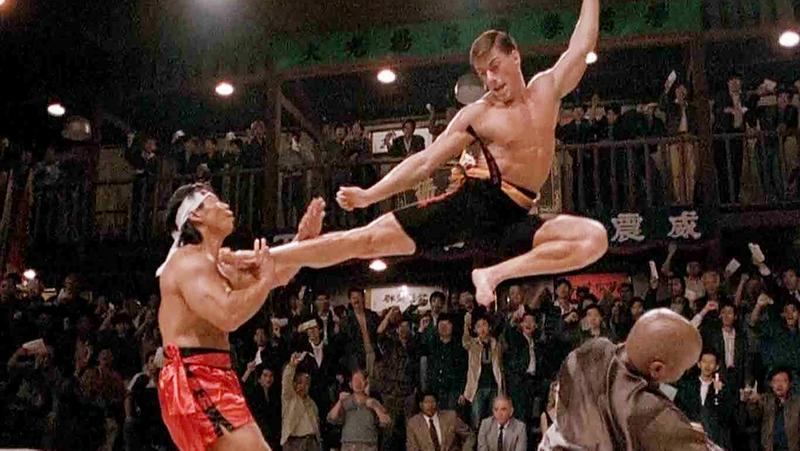The High Flying & Questionable History Of Jean-Claude Van Damme's Bloodsport
By | January 9, 2022

“Bloodsport”, the 1988 Jean-Claude Van Damme classic, set the bar for action movies that simultaneously combine cheesy acting with amazing fight scenes. It was based on the “real-life” story of “ex-CIA” operative Frank Dux (more on his credibility later). “Bloodsport” introduced Van Damme along with his endless splits and roundhouse kicks to the world at large.
Prior to the film, for which he was only paid $25,000, "The Muscles from Brussels" worked as a limo driver, pizza boy, and carpet factory worker. The ‘80s action staple started an iconic run of action movies for Van Damme, all featuring his signature kick. Here’s the story behind “Kumite! Kumite! Kumite!”

The Real Frank Dux
The central character of “Bloodsport” was a real guy named Frank Dux. However, that would appear to be the only true-to-life aspect of the story. Dux, who owned a number of martial arts gyms in the L.A. area, met screenwriter Sheldon Lettich through Dux’s agent. As Sheldon told it, “Frank told me a lot of tall tales, most of which turned out to be bullshit,” but “his stories about participating in this so-called ‘Kumite’ event sounded like a great idea for a movie."
Lettich, who had some juice after working on Rambo III, pitched the idea to producer Mark DiSalle who loved the idea. It wasn’t until after the film premiered that they learned many of Dux’s life experiences were made up. The L.A Times ran a story debunking Dux’s tale of traveling the world and fighting in an ultra-secretive, fight to the death tournament. As they learned, Dux had never been east of San Diego much less Hong Kong, and his trophy from the supposed “Kumite” in the Bahamas was actually made in the San Fernando Valley.

Van Damme’s Big Break
Of course, since Van Damme's entire acting resume consisted of some work as an extra, it took some luck to land the starring role. Born Jean-Claude Camille François Van Varenberg, the brawny Belgium snuck into “Bloodsport'' by nearly taking a producer's head off.
On the street, he recognized producer Menahem Golan and went to reintroduce himself. As Lettich recalls, “Jean-Claude saw Menahem on the street and said, ‘Hey Menahem, remember me? Jean-Claude Van Damme.'”
Apparently, the producer decidedly did not remember and Van Damme for emphasis, “did a kick that missed (Golan’s) face by like two inches.” Van Damme’s version of the story was more concise, “I did my split, I showed my muscles, I said ‘I’m the best, and I’m not too expensive right now.’”

Almost Lost To History
At first, producers wanted to cast Michael Dudikoff. Dudikoff starred in a number of ‘80s action movies you probably never heard of like the “American Ninja”, “Avenging Force”, and “Platoon Leader”. Apparently, being 6’2” for some reason nixed his chances of playing Frank Dux. That led to Van Damme who producer Mark Di Salle hoped would appeal to both sexes. ”I wanted to find a new martial arts star who was a ladies’ man. Jean Claude appeals to both men and women. He’s an American hero who fights for justice the American way and kicks the stuffing out of the bad guys.”
Even with Van Damme’s spinning kicks and vigorous splits, the film was almost sent straight to video. Reportedly, Golan hated the original cut telling Lettich, “I’m not gonna release it in theaters. That movie’s terrible; I’m putting it straight to video.” Thankfully, some re-edits by Michael J. Duthie and Van Damme himself, made the fighting the focus and saved the film from the dustbin of history.

Realism
While Dux’s story was likely all tall tales, the producers managed to create a sense of realism. One of their best decisions was using real fighters rather than stuntmen. Paulo Tocha, who played Paco, was an actual Muay Thai champion. The same was true for Michel Qissi, who played kickboxer Suan Paredes. The central antagonist, Chong Li, was played by Chinese martial artist and bodybuilder Bolo Yeung. Owner of pecs the size of New York pizzas, Chong Li in a hat tip to the one and only Bruce Lee reminded us all that “brick did not hit back.”

A Surprising Success
Despite some critics calling the film a “jungle of cliche and reservoir of bad acting”, it managed to gross $50 million on a budget of just $2 million. Producer Golan himself didn’t exactly back Van Damme saying, “This guy’s never gonna make it… He’s a loser, he’s a terrible actor… Michael Dudikoff is a movie star! Jean-Claude is poison!”
Thankfully, Golan was dead wrong. Otherwise, Van Damme might have forever regretted getting fired off of the Arnold Swarzenegger movie “Predator.” Apparently, Van Damme complained that the alien suit was too restrictive and the script failed to show off his martial arts prowess. Although, Van Damme pleading to do his splits as the Predator is worthy of an SNL skit.
